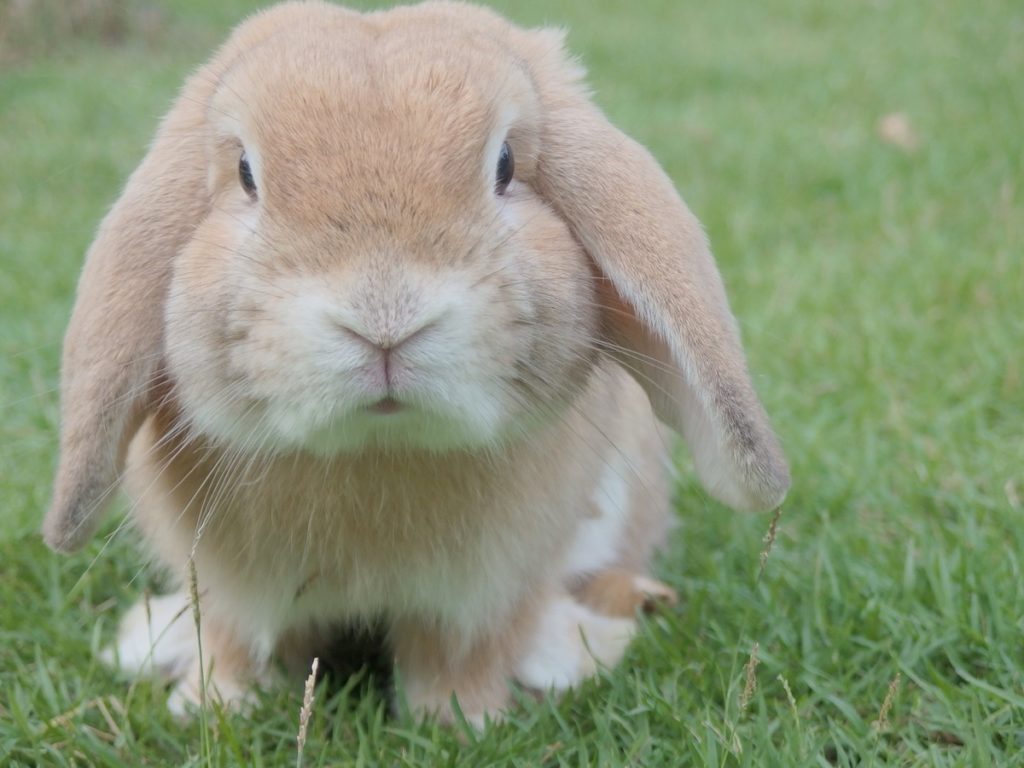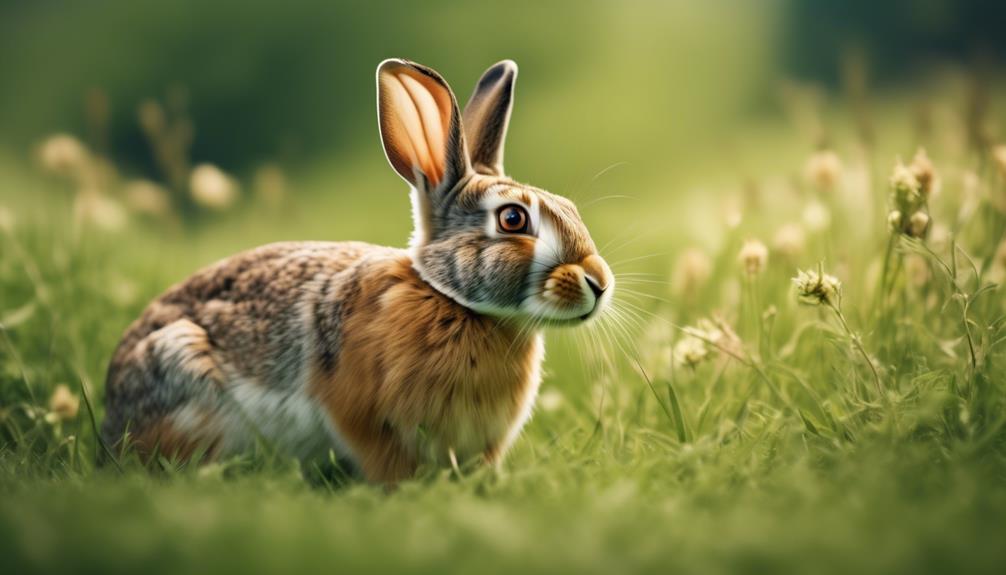
Are you aware of the crucial role that the endangered European rabbit plays as a vital prey species? With its delicate features and remarkable agility, this small creature has captivated the attention of scientists and conservationists alike.
But why is the conservation of this species so important? What impact does it have on the delicate balance of ecosystems?
In this discussion, we will explore the significance of the European rabbit as a prey species and unravel the fascinating complexities of its existence. Prepare to be enlightened and amazed as we delve into the world of this endangered species and uncover the vital role it plays in our natural world.
Key Takeaways
- European rabbits play a crucial role in ecosystems as primary consumers, controlling vegetation through grazing and contributing to nutrient cycling.
- They provide shelter for other species in their burrows and serve as a vital food source for numerous predators, ensuring a steady source of food for them.
- The European rabbit’s population dynamics impact predator populations in the ecosystem, and they help maintain the balance of plant species and prevent overgrowth.
- However, the European rabbit population is threatened by diseases like myxomatosis and rabbit hemorrhagic disease, as well as habitat loss, putting them at risk of extinction. Urgent conservation efforts are needed to protect their habitats and prevent disease spread.
Importance of European Rabbit in Ecosystems
The European rabbit plays a crucial role in ecosystems as a prey species, contributing to the balance and functioning of the natural environment. As a primary consumer, it helps control vegetation by grazing on grass, leaves, and twigs, preventing overgrowth and promoting biodiversity.
Its burrows provide shelter for a variety of other species, including insects, reptiles, and small mammals.
The rabbit’s reproductive habits, with females giving birth to multiple litters annually, ensure a steady source of food for predators, such as foxes, birds of prey, and carnivorous mammals, helping to maintain their populations.
Additionally, the rabbit’s presence influences nutrient cycling through its diet and waste, contributing to the overall health and productivity of the ecosystem.
European Rabbit’s Role as a Prey Species
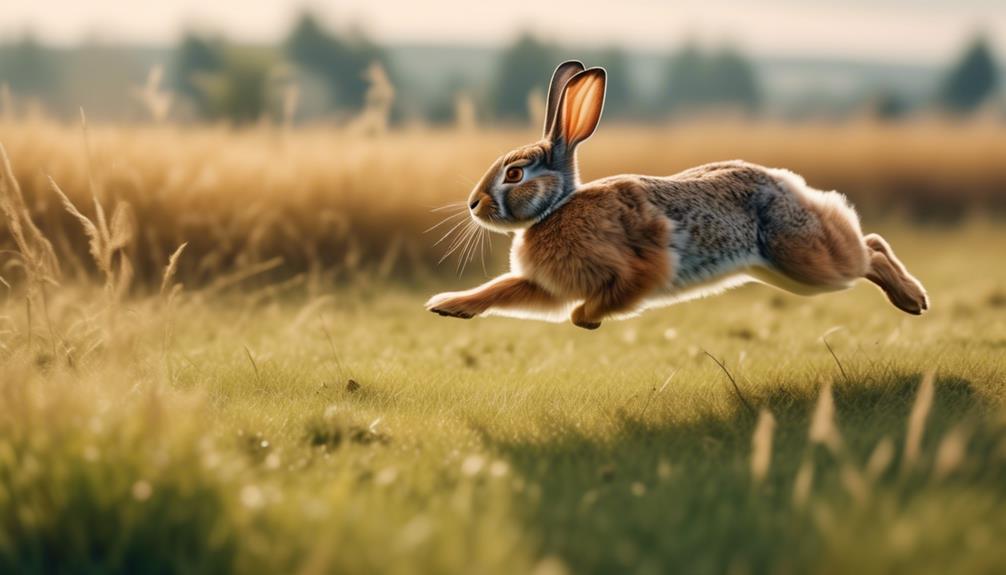
To fully understand the European Rabbit’s role as a prey species, it’s important to examine its interactions within the ecosystem.
- Predator-Prey Relationships: As a primary prey species, the European Rabbit serves as a vital food source for numerous predators, including birds of prey, foxes, and carnivorous mammals. Its population dynamics directly impact the predator populations in the ecosystem.
- Ecosystem Balance: By controlling vegetation through grazing, the European Rabbit helps maintain the balance of plant species and prevents overgrowth. This, in turn, affects the abundance and diversity of other species in the ecosystem.
- Nutrient Cycling: The rabbit’s diet of grass, leaves, and twigs contributes to nutrient cycling within the ecosystem. Their digestion and subsequent droppings enrich the soil, promoting plant growth and providing food for decomposers.
- Indicators of Ecosystem Health: The presence and abundance of European Rabbits can serve as indicators of ecosystem health. Their decline or disappearance may suggest imbalances or disturbances within the ecosystem that require further investigation and conservation efforts.
European Rabbit’s Physical Characteristics
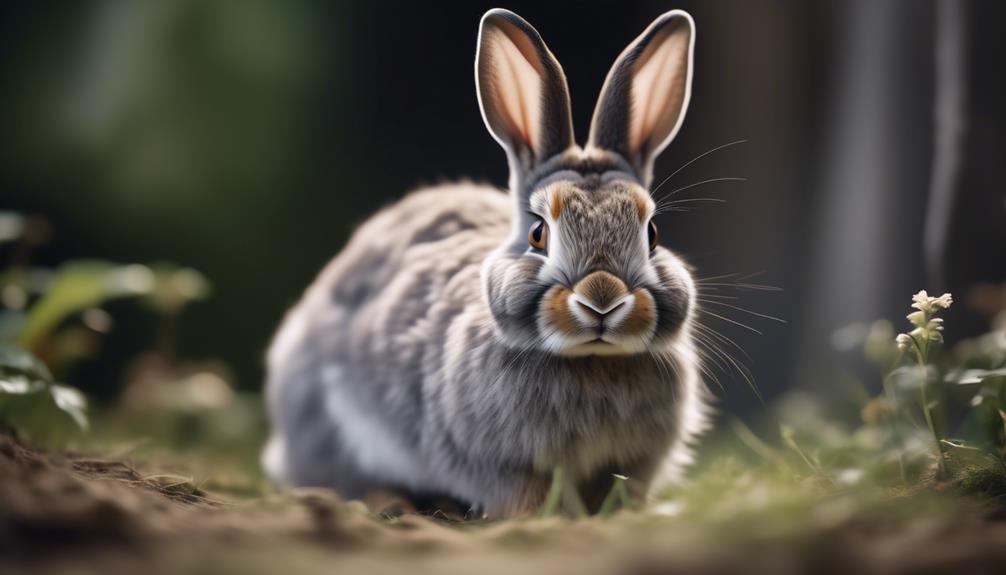
With its soft and dense fur, long upright ears, and large round eyes, the European Rabbit showcases a distinctive set of physical characteristics. Weighing between 2.25 and 5.5 pounds, this small creature has a semi-arched or mandolin-shaped body. Its fur comes in various colors and patterns, providing effective camouflage in its natural habitat.
The long and upright ears serve a dual purpose, allowing the rabbit to detect predators and regulate body temperature. The large round eyes provide excellent vision, aiding in navigation and foraging. Another interesting feature is its continuously growing teeth, which help the rabbit maintain its herbivorous diet of grass, leaves, and twigs.
These physical traits, along with its shy and solitary temperament, make the European Rabbit well-suited for outdoor habitats.
European Rabbit’s Habitat and Distribution
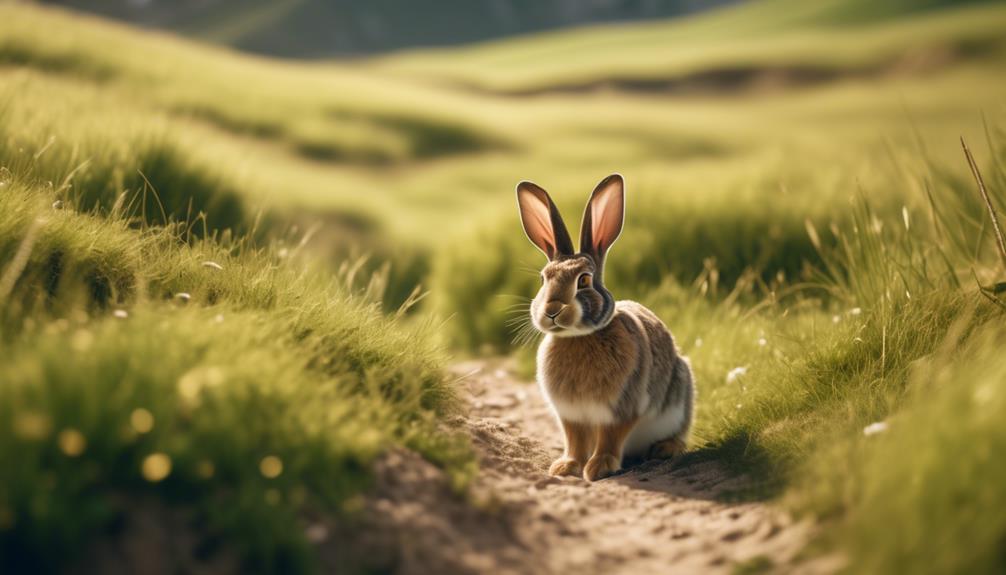
European Rabbits can be found throughout Europe and Northwest Africa, as well as in introduced populations in South America, Australia, and New Zealand.
Here are some key points about the habitat and distribution of European Rabbits:
- Native Range: European Rabbits are native to Europe and Northwest Africa, where they inhabit a variety of habitats including grasslands, woodlands, and coastal areas.
- Introduced Populations: Humans have introduced European Rabbits to other parts of the world, such as South America, Australia, and New Zealand. These introduced populations have established themselves successfully in these new environments.
- Habitat Preferences: European Rabbits prefer open areas with plenty of vegetation for cover and food. They’re often found in meadows, pastures, and agricultural fields.
- Range Expansion: European Rabbits have a high reproductive rate and can quickly colonize new areas. They’ve expanded their range significantly in introduced populations, sometimes causing negative impacts on local ecosystems.
Threats to the European Rabbit Population
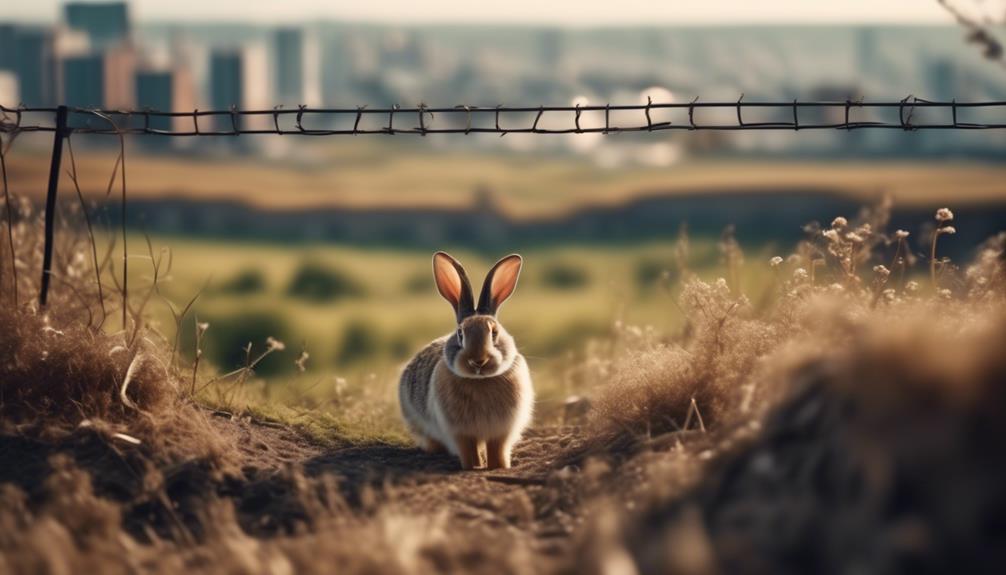
The declining population of the European Rabbit is primarily due to habitat loss and diseases. As human activities continue to encroach upon their natural habitats, rabbits are losing their homes and essential resources. Rapid urbanization, agriculture expansion, and deforestation are the main culprits behind habitat loss. Additionally, diseases like myxomatosis and rabbit hemorrhagic disease (RHD) have had devastating impacts on rabbit populations. These diseases can spread rapidly and have high mortality rates, making it difficult for the rabbits to recover. The combination of habitat loss and diseases has put the European Rabbit at risk of extinction. Urgent conservation efforts are needed to protect their habitats and prevent the spread of diseases to ensure the survival of this vital prey species.
| Threats to the European Rabbit Population | ||
|---|---|---|
| Habitat Loss | Diseases | |
| – Urbanization | – Myxomatosis | |
| – Agriculture | – RHD | |
| – Deforestation |
European Rabbit’s Behavior and Social Structure
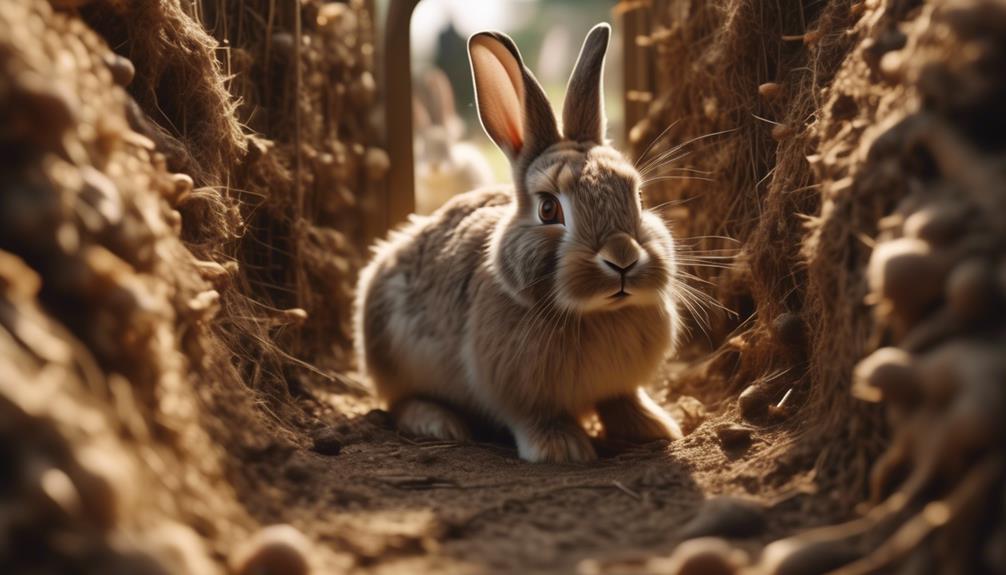
Rabbits, known for their shy and skittish temperament, exhibit intriguing behavior patterns and live in complex social structures.
- Social Structure: European rabbits live in colonies called warrens. These warrens consist of interconnected burrows where rabbits seek shelter and protection. Within the warren, rabbits establish hierarchies based on dominance and territorial boundaries.
- Group Dynamics: While rabbits are generally solitary animals, they do interact with other members of their warren. They engage in social grooming, play, and communicate through body language and vocalizations.
- Nocturnal Behavior: European rabbits are primarily active during the night, using their excellent hearing and vision to navigate and forage for food. They’re most active during the early morning and late evening hours.
- Communication: Rabbits use a variety of methods to communicate with each other. They rely on body language, such as ear positioning and tail movements, to signal their intentions. They also use scent marking and vocalizations, including grunts, growls, and squeaks, to convey different messages to their warren mates.
Understanding the behavior and social structure of European rabbits is crucial for their conservation and management, as it provides insights into their ecological role within ecosystems and helps identify the best strategies for their protection.
European Rabbit’s Nocturnal Activity Patterns
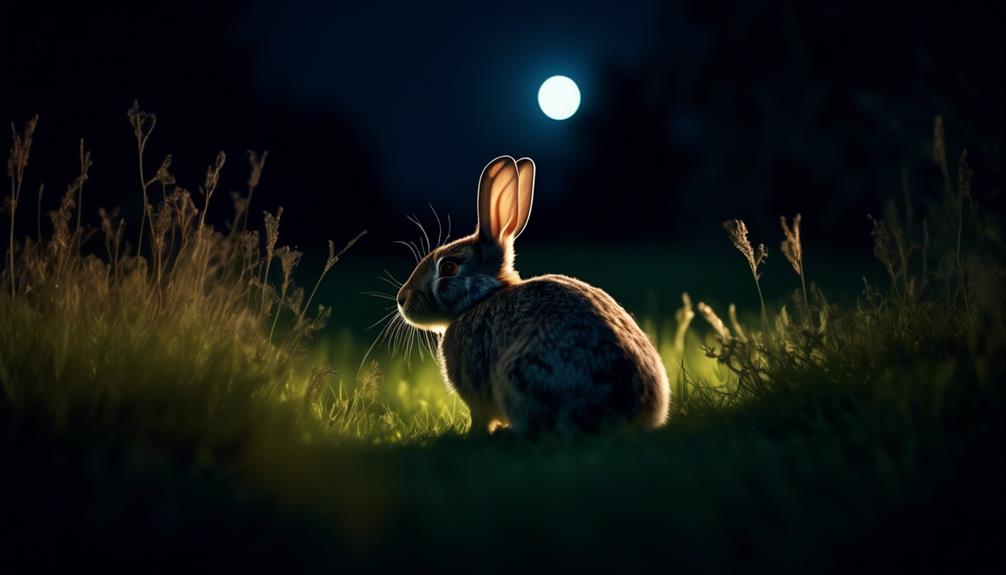
During the night, European rabbits demonstrate their most active behavior patterns, utilizing their excellent hearing and vision to navigate and forage for food. As nocturnal animals, they’ve adapted to this lifestyle by developing large, round eyes that are highly sensitive to even the slightest movement in the darkness. Their exceptional hearing allows them to detect predators and other potential threats, ensuring their survival in the wild.
Under the cover of darkness, European rabbits venture out of their warrens, which are their underground burrows, to search for their herbivorous diet of grass, leaves, and twigs. They move swiftly and silently, taking advantage of their agile bodies to escape danger and find sustenance.
This nocturnal activity pattern is crucial for their survival and plays a significant role in the maintenance of their population.
European Rabbit’s Diet and Feeding Habits
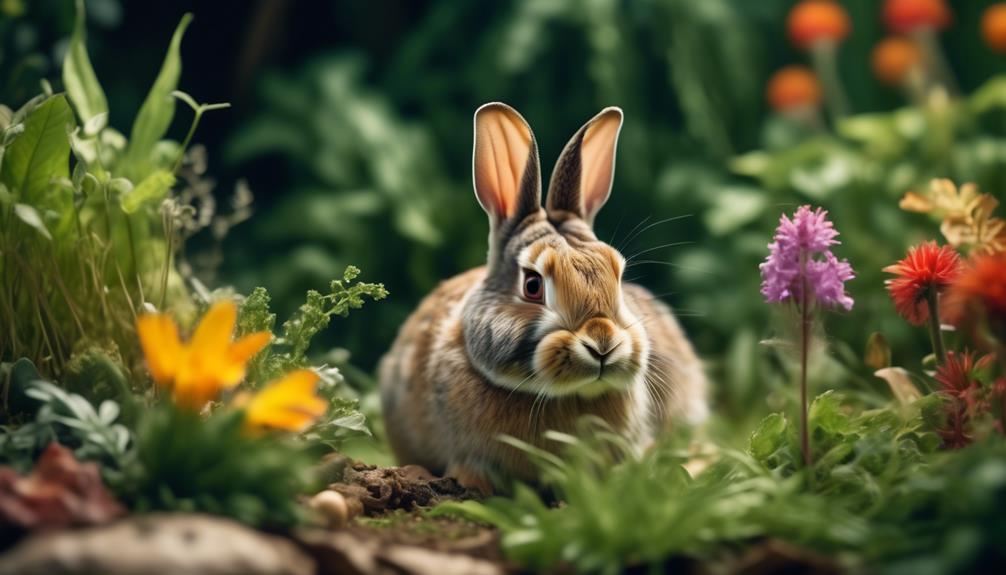
European rabbits have a herbivorous diet consisting primarily of grass, leaves, and twigs. They rely on these plant materials to meet their nutritional needs and sustain their energy levels. Here are some key aspects of the European rabbit’s diet and feeding habits:
- Grazing: They spend a significant amount of time grazing on grass, which forms a major part of their diet. This helps them obtain essential nutrients and fiber.
- Leaf consumption: European rabbits also feed on a variety of leaves, including those from shrubs and trees. Leaves provide them with additional nutrients and serve as a source of hydration.
- Twig nibbling: Rabbits have a natural inclination to nibble on twigs. This behavior helps keep their teeth in check, as their teeth continuously grow throughout their lives.
- Coprophagy: Surprisingly, rabbits practice coprophagy, which is the consumption of their own feces. This unusual behavior allows them to extract additional nutrients from their food by re-digesting it.
European Rabbit’s Reproduction and Breeding Habits
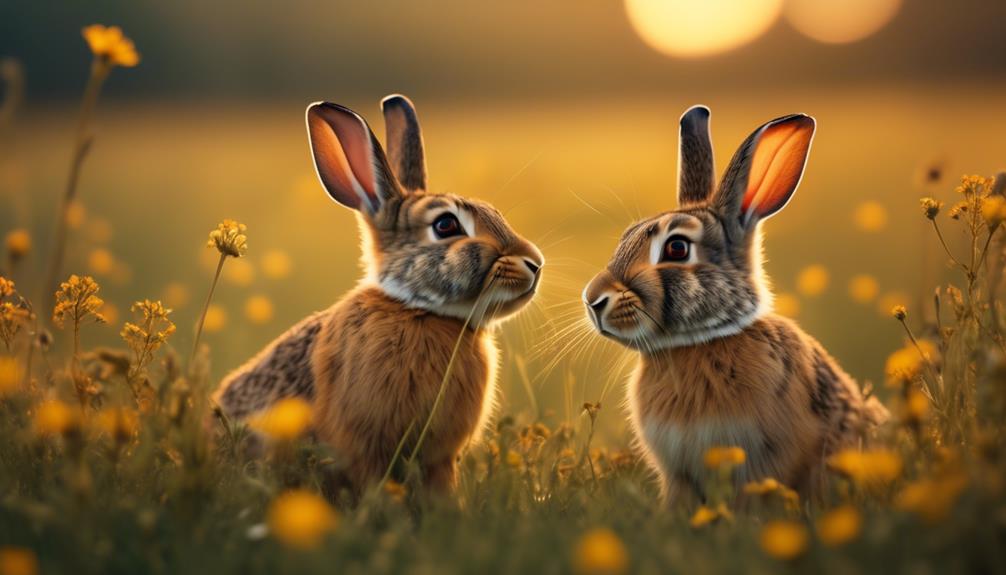
European rabbits have a unique reproductive strategy that allows them to breed throughout the year. Females, known as does, can have multiple litters annually. They have a short gestation period of about 30 days. Once the kits are born, the mother feeds them with milk for about four weeks. After that, the kits start to eat solid food and become more independent.
European rabbits are known for their rapid breeding habits, with each litter ranging from three to twelve kits. This high reproductive rate helps to maintain their population numbers. Male rabbits, known as bucks, play a crucial role in the breeding process by competing with other males for the opportunity to mate with the females.
European Rabbit’s Communication Methods
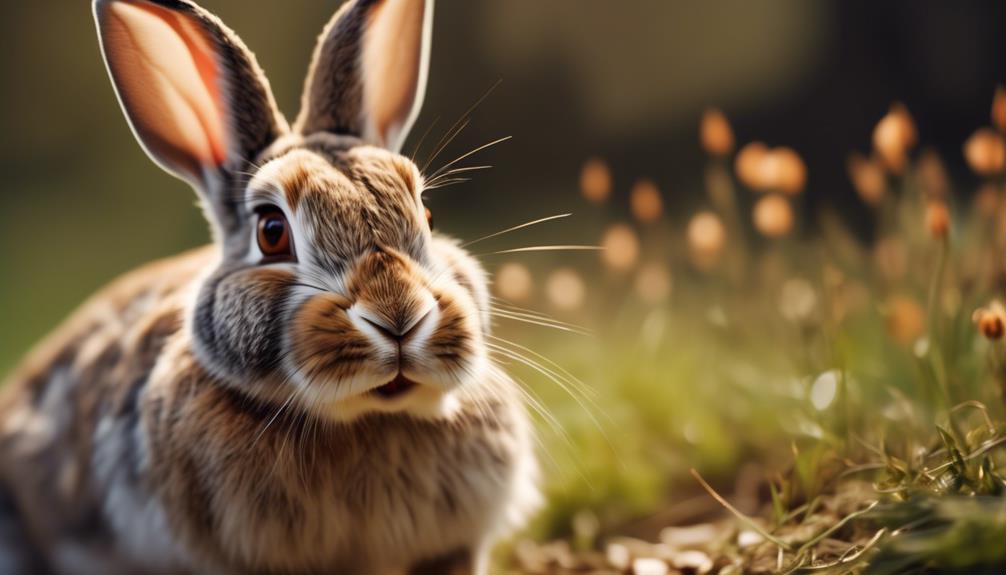
European rabbits communicate through various methods. These include body language, scent marking, vocalizations, and visual signals. These communication methods allow them to convey information to other rabbits in their colony and to potential predators or mates.
- Body language: Rabbits use various body movements and postures to communicate their intentions and feelings. For example, they may thump their hind legs on the ground to alert others of danger or stand upright on their hind legs to express dominance or aggression.
- Scent marking: Rabbits have scent glands located on their chin, chest, and anal area. They use these glands to mark their territory and communicate with other rabbits through the release of specific scents.
- Vocalizations: Rabbits make a range of vocal sounds to communicate different messages. They may grunt, growl, squeal, or purr to express emotions such as fear, pain, or contentment.
- Visual signals: Rabbits also use visual cues, such as ear position, tail movement, and eye contact, to communicate with each other. These visual signals help them establish social hierarchies and maintain group cohesion.
Conservation Efforts for the European Rabbit
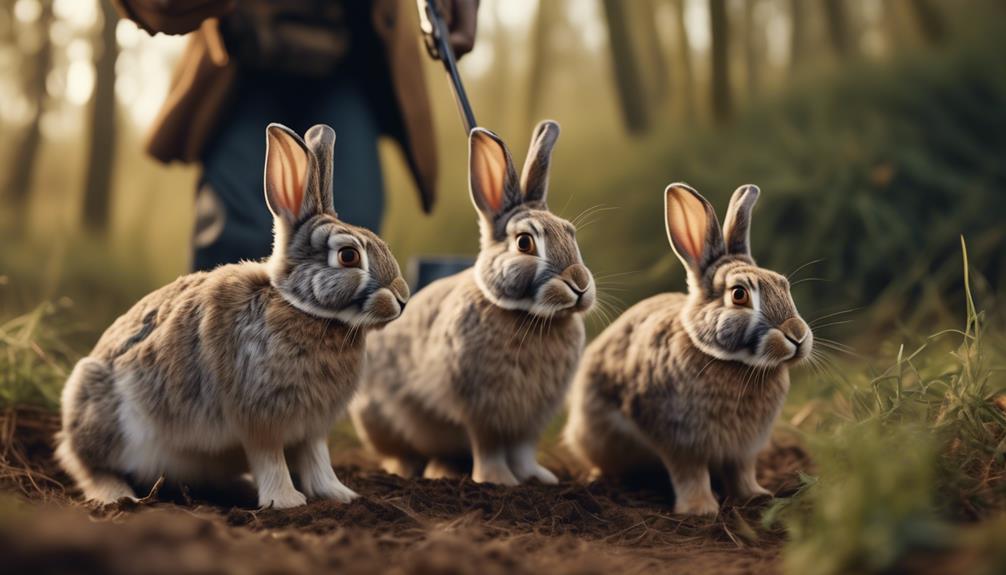
Conservation efforts are being implemented to protect the endangered European Rabbit from further population decline. Due to habitat loss and diseases, the European Rabbit population has been steadily decreasing, making them a near-threatened species.
To combat this decline, various initiatives have been put in place. One approach is the preservation and restoration of suitable habitats for the rabbits. This includes protecting natural grasslands and creating safe spaces for the rabbits to live and breed.
Additionally, measures are being taken to control and prevent the spread of diseases that pose a threat to the rabbit population. This involves monitoring and managing populations, as well as implementing vaccination programs.
Public awareness campaigns are also being conducted to educate people about the importance of conserving the European Rabbit and its role as a vital prey species in ecosystems.
Through these efforts, it’s hoped that the European Rabbit population can be stabilized and their future secured.
European Rabbit’s Historical Evolution and Origin
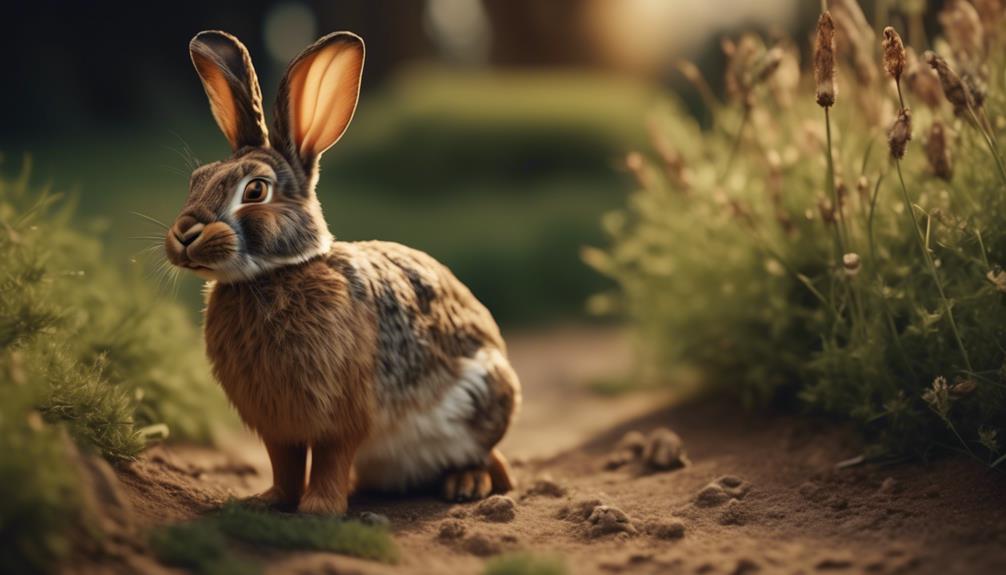
To understand the historical evolution and origin of the European Rabbit, it’s important to examine its early ancestry and the factors that contributed to its development as a distinct species.
- European Rabbit, known as Oryctolagus cuniculus, is the ancestor of most domesticated rabbit breeds.
- Evolution: First evolved around 4,000 years ago in Spain.
- Conservation Status: Near-threatened, with declining population due to habitat loss and diseases.
- Introduction: European Rabbits were introduced to South America, Australia, and New Zealand.
The European Rabbit’s historical evolution can be traced back to its origins in Spain, where it first emerged as a distinct species around 4,000 years ago. Today, it serves as the ancestor of most domesticated rabbit breeds.
However, despite its widespread distribution throughout Europe and Northwest Africa, the European Rabbit is currently classified as near-threatened due to declining populations caused by habitat loss and diseases.
Additionally, it has been introduced to various regions around the world, including South America, Australia, and New Zealand.
Understanding the historical evolution and origin of the European Rabbit is vital in developing effective conservation strategies to protect this important prey species.
Comparison With Comparable Rabbit Breeds
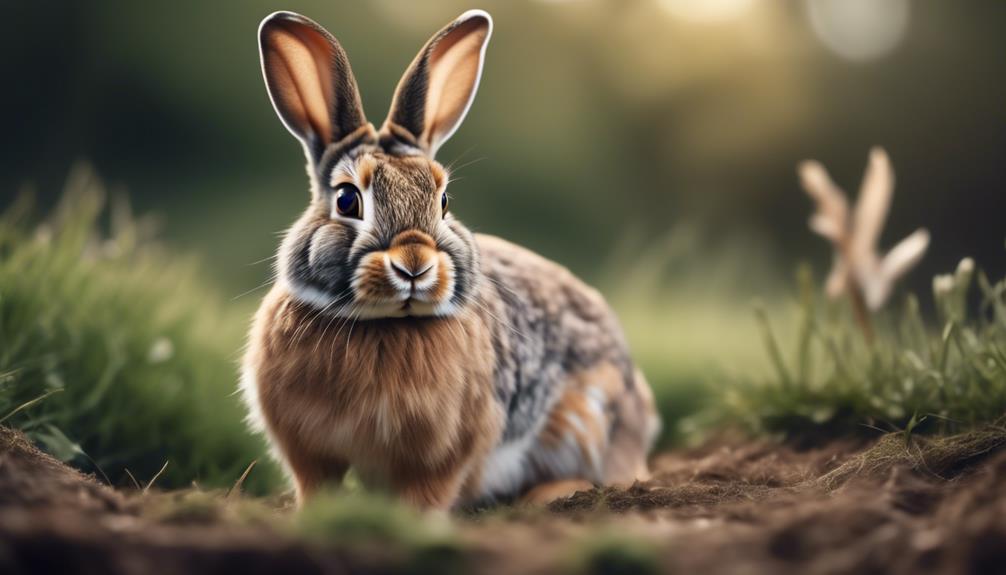
When comparing the European Rabbit to other rabbit breeds, it’s important to consider their physical characteristics and temperament.
The European Rabbit, also known as Oryctolagus cuniculus, is the ancestor of most domesticated rabbit breeds. In terms of physical characteristics, European Rabbits typically weigh between 2.25 and 5.5 pounds and have a semi-arch or mandolin body shape. Their fur is soft and dense, and they come in various colors and patterns. European Rabbits have long, upright ears and large, round eyes. Another unique feature is their continuously growing teeth.
In terms of temperament, European Rabbits are shy, solitary, and skittish. They’re best suited for outdoor habitats and are considered to be small or mini-sized rabbits.
European Rabbit’s Conservation Status
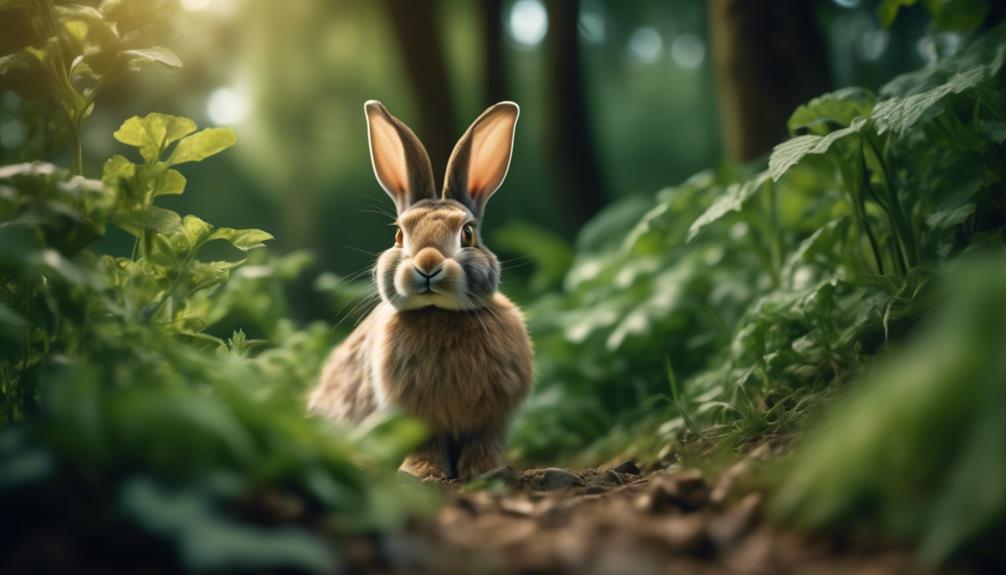
With a near-threatened conservation status, the European Rabbit faces declining populations due to habitat loss and diseases.
The following are important points to understand about the European Rabbit’s conservation status:
- Habitat: The European Rabbit is found throughout Europe and Northwest Africa. It has also been introduced to South America, Australia, and New Zealand.
- Introduction: Due to human interference, the European Rabbit has been introduced to various regions outside its native range.
- Threats: The declining population of European Rabbits is primarily attributed to habitat loss caused by urbanization, agriculture, and deforestation. Diseases, such as myxomatosis and rabbit hemorrhagic disease, also pose a significant threat.
- Importance: The European Rabbit plays a crucial role in ecosystems as a prey species. Its decline can have cascading effects on predator populations and overall ecosystem health. Conservation efforts are needed to ensure its survival and maintain the balance of ecosystems.
Best Suited Environments for European Rabbits
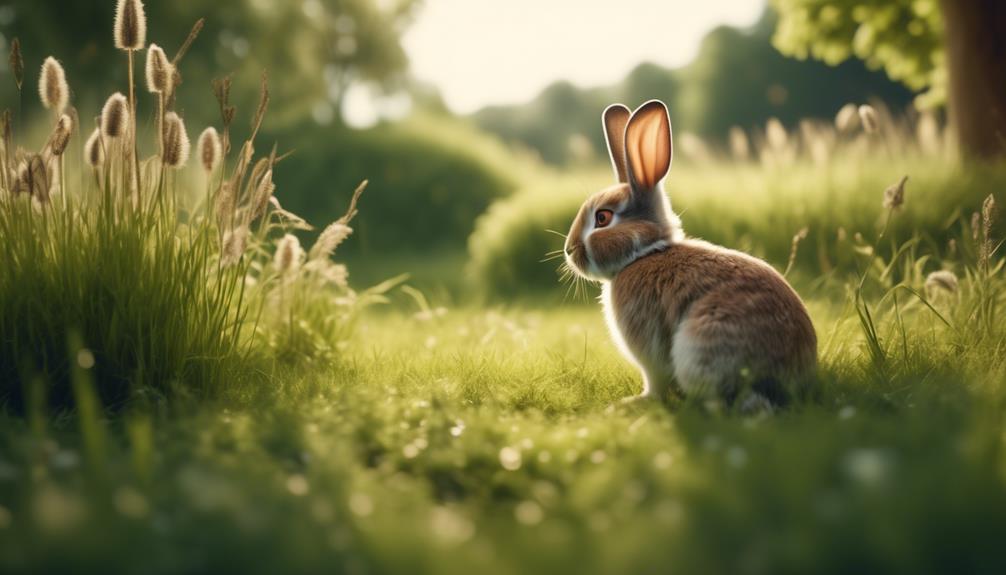
As we shift our focus to the best suited environments for European Rabbits, it’s important to consider the specific conditions that facilitate their survival and well-being.
European rabbits are best suited for outdoor environments where they can thrive in their natural habitat. They prefer areas with ample vegetation such as grasslands, meadows, and open woodlands. These environments provide them with abundant food sources like grass, leaves, and twigs, which make up their herbivorous diet.
European rabbits also prefer areas with suitable hiding places and burrows, such as dense shrubs or thickets, where they can seek shelter from predators.
Additionally, they thrive in temperate climates with moderate temperatures and rainfall. By creating and preserving these ideal environments, we can help ensure the survival and conservation of the endangered European rabbit species.
Frequently Asked Questions
What Are Some Comparable Rabbit Breeds to the European Rabbit?
Some comparable rabbit breeds to the European rabbit are the Belgian Hare and the Swedish Hare. They have similar physical characteristics such as weight, body shape, fur, ears, and eyes.
How Do European Rabbits Communicate With Each Other?
European rabbits communicate with each other through body language, scent marking, and vocalizations. They use these methods to convey messages and establish social hierarchies within their colonies.
What Are the Specific Physical Characteristics of European Rabbits?
The physical characteristics of European rabbits include a weight range of 2.25-5.5 lb, a semi-arch/mandolin body shape, soft and dense fur in various colors and patterns, long upright ears, large round eyes, and continuously growing teeth.
What Are the Best Environments for European Rabbits to Thrive In?
European rabbits thrive best in outdoor environments. They prefer small or mini-sized spaces. They are shy, solitary, and skittish, so they need a quiet and peaceful setting. Provide them with grass, leaves, and twigs for their herbivorous diet.
Are There Any Ongoing Conservation Efforts Dedicated to Protecting the European Rabbit?
Yes, there are ongoing conservation efforts dedicated to protecting the European rabbit. These efforts aim to address habitat loss and diseases that have led to its declining population.
What Threats Are Causing the Decline of the European Rabbit Population?
The European rabbit population is facing multiple threats, leading to a decline. Habitat loss, disease, and predation by invasive species are negatively impacting their numbers. Additionally, competition with other species for resources and the effects of climate change are further endangering the European rabbit population. The endangered Columbia Basin pygmy rabbit serves as a reminder of the consequences of declining rabbit populations.
Conclusion
In conclusion, the European rabbit isn’t only a visually stunning creature but also a vital prey species in ecosystems. Its decline in population due to habitat loss and diseases is a concerning issue.
As a key prey species, the European rabbit plays a crucial role in maintaining the balance of its ecosystem. Conservation efforts are necessary to protect this species and ensure its survival in the future.

